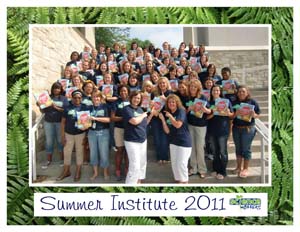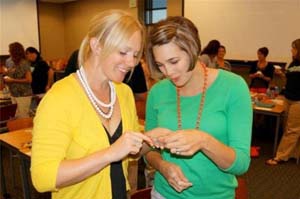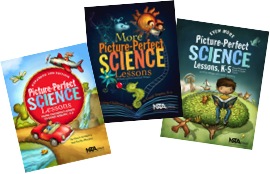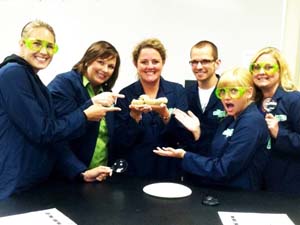A Picture Perfect Approach to Connecting Reading Strategies and Science
By Guest Blogger
Posted on 2014-08-05
Building an elementary program connecting literary and science can be an overwhelming thought. The common core standards address the need for reading complex informational text at an early age. Infusing the language arts block with rich, age-appropriate content knowledge and vocabulary in science is essential. Having students listen to informational read-alouds in the early grades helps lay the necessary foundation for students’ reading and understanding of increasingly complex texts on their own in subsequent grades.
 Using Picture Perfect Science resources became part of the foundation for our teachers to successfully connect literacy and STEM (Science, Technology, Engineering and Mathematics). We’ve found author visits to be a key factor in teacher buy in. Over the past several years, we invited the Picture Perfect Science (PPS) authors Emily Morgan and Karen Ansberry to visit and work with our teachers. Starting off with a five-day workshop was a tremendous success in getting our teachers familiar with inquiry, reading strategies, and the BSCS 5E (Engage, Explore, Explain, Elaborate, and Evaluate) model of instruction. Karen and Emily modeled lessons and went in-depth with our teachers about using the lessons in the K–6 classrooms. You can learn more about the background of PPS by watching authors Emily Morgan and Karen Ansberry discuss Picture-Perfect Science Lessons on the NSTA YouTube channel.
Using Picture Perfect Science resources became part of the foundation for our teachers to successfully connect literacy and STEM (Science, Technology, Engineering and Mathematics). We’ve found author visits to be a key factor in teacher buy in. Over the past several years, we invited the Picture Perfect Science (PPS) authors Emily Morgan and Karen Ansberry to visit and work with our teachers. Starting off with a five-day workshop was a tremendous success in getting our teachers familiar with inquiry, reading strategies, and the BSCS 5E (Engage, Explore, Explain, Elaborate, and Evaluate) model of instruction. Karen and Emily modeled lessons and went in-depth with our teachers about using the lessons in the K–6 classrooms. You can learn more about the background of PPS by watching authors Emily Morgan and Karen Ansberry discuss Picture-Perfect Science Lessons on the NSTA YouTube channel.
 The graph at the right shows the shift in our teacher’s comfort level with the reading strategies after working with the PPS authors (click to enlarge).
The graph at the right shows the shift in our teacher’s comfort level with the reading strategies after working with the PPS authors (click to enlarge).
The PPS lessons came alive using children’s literature and the 5Es and helped teachers make the most of their day with so many standards and so little time. Integrating fiction and non-fiction science literature into the language arts block helps teachers utilize their time while addressing Common Core State Standards and Next Generation Science Standards. Although the Picture Perfect Science Lessons are primarily books for teaching science, reading comprehension strategies are embedded in each lesson.
 A key factor to successfully implementing the lessons is to get the needed materials in the hands of the teachers. We began with getting Picture Perfect Science Lessons and More Picture Perfect Science Lessons in the hands of as many teachers as possible. I believe that if teachers have easy access to a resource there is a greater chance of them using the resource on a regular basis. The next step was for teachers to have easy access to book collections. If we expect teachers to incorporate children’s literature in the science lessons we need to have the books accessible. NSTA Press has created book collections that are a lifesaver for teachers locating hard to find books. Currently multiple book collections are in each building and our goal is for each teacher to eventually have a book collection in their classroom. Class packs have been a great invention to help get needed materials in the hands of teachers. NSTA Press has begun creating class packs for the PPS lessons. In the process Even More Picture Perfect Science Lessons has been published and we are working to get the books into our schools. Next Time You See… series of children’s books authored by Emily Morgan are also a resource our teachers love to share with their students. Visit the NSTA Press YouTube channel for author talks.
A key factor to successfully implementing the lessons is to get the needed materials in the hands of the teachers. We began with getting Picture Perfect Science Lessons and More Picture Perfect Science Lessons in the hands of as many teachers as possible. I believe that if teachers have easy access to a resource there is a greater chance of them using the resource on a regular basis. The next step was for teachers to have easy access to book collections. If we expect teachers to incorporate children’s literature in the science lessons we need to have the books accessible. NSTA Press has created book collections that are a lifesaver for teachers locating hard to find books. Currently multiple book collections are in each building and our goal is for each teacher to eventually have a book collection in their classroom. Class packs have been a great invention to help get needed materials in the hands of teachers. NSTA Press has begun creating class packs for the PPS lessons. In the process Even More Picture Perfect Science Lessons has been published and we are working to get the books into our schools. Next Time You See… series of children’s books authored by Emily Morgan are also a resource our teachers love to share with their students. Visit the NSTA Press YouTube channel for author talks.
NSTA Press Author Emily Morgan Discusses Her Series, Next Time You See
During the course of our projects we created over 20 instructional vignettes featuring best practices and the PPS lessons. Many teachers that have a lack of confidence teaching science often avoid the topic. The eight- to twelve-minute instructional vignettes highlight our teachers utilizing effective teaching strategies and ways to engage students in the lesson. The vignettes are designed for teachers to watch before teaching the lesson. Our teachers are featured in the vignettes so that other teachers can relate to a colleague and build confidence to embrace the science lesson compared to avoiding the engaging lessons. For example, The Chemical Cafe’ Lesson involves some set-up that a teacher would benefit from knowing in advance. Fourth-grade teacher, Stephanie Dean shares some of the challenges and what she would do differently next time she teaches the lesson. The chemical change cafe’ vignette can be viewed at http://stuckonscienceonline.com/?post_type=videos&p=408.
Visit www.stuckonscienceonline.com for vignettes, instructional e-magazines, and resources.
 Note: To order any of the books noted in this blog, including the Picture Perfect Science and Next Time You See book series, or to explore NSTA book collections, go to http://www.nsta.org/store. You can also download a free e-book about Picture-Perfect Science, “Why Read Picture Books in Science Class?”.
Note: To order any of the books noted in this blog, including the Picture Perfect Science and Next Time You See book series, or to explore NSTA book collections, go to http://www.nsta.org/store. You can also download a free e-book about Picture-Perfect Science, “Why Read Picture Books in Science Class?”.
Today’s guest blogger is Kim Stilwell, an education consultant who plans and conducts professional development workshops. Kim, along with her colleague, Chris Gibler, are presenters in the August 6 NSTA Virtual Conference on Connecting Literacy and Science with NGSS and Common Core, where they will share how using Picture Perfect Science resources became part of the foundation to successfully connecting literacy and science in their district. Learn more and register for the Virtual Conference here. For all resources on NGSS, visit the NGSS@NSTA Hub.
Disclaimer: The views expressed in this blog post are those of the author(s) and do not necessarily reflect the official position of the National Science Teaching Association (NSTA).


